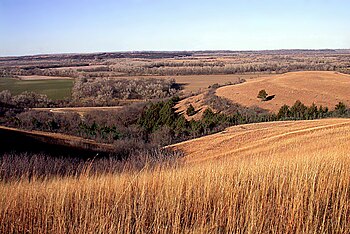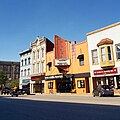Portal:Kansas
The Kansas Portal Kansas (/ˈkænzəs/ ⓘ KAN-zəss) is a landlocked state in the Midwestern region of the United States. It borders Nebraska to the north; Missouri to the east; Oklahoma to the south; and Colorado to the west. Kansas is named after the Kansas River, in turn named after the Kansa people. Its capital is Topeka, and its most populous city is Wichita, however the largest urban area is the bi-state Kansas City, MO–KS metropolitan area. For thousands of years, what is now Kansas was home to numerous and diverse Indigenous tribes. The first settlement of non-indigenous people in Kansas occurred in 1827 at Fort Leavenworth. The pace of settlement accelerated in the 1850s, in the midst of political wars over the slavery debate. When it was officially opened to settlement by the U.S. government in 1854 with the Kansas–Nebraska Act, conflict between abolitionist Free-Staters from New England and pro-slavery settlers from neighboring Missouri broke out over the question of whether Kansas would become a free state or a slave state, in a period known as Bleeding Kansas. On January 29, 1861, Kansas entered the Union as a free state, hence the unofficial nickname "The Free State". Passage of the Homestead Acts in 1862 brought a further influx of settlers, and the booming cattle trade of the 1870s attracted some of the Wild West's most iconic figures to western Kansas. As of 2015, Kansas was among the most productive agricultural states, producing high yields of wheat, corn, sorghum, and soybeans. In addition to its traditional strength in agriculture, Kansas possesses an extensive aerospace industry. Kansas, which has an area of 82,278 square miles (213,100 square kilometers) is the 15th-largest state by area, the 36th most-populous of the 50 states, with a population of 2,940,865 according to the 2020 census, and the 10th least densely populated. Residents of Kansas are called Kansans. Mount Sunflower is Kansas's highest point at 4,039 feet (1,231 meters). (Full article...) This is a Good article, an article that meets a core set of high editorial standards.
The Battle of Mine Creek, also known as the Battle of Little Osage, was fought on October 25, 1864, in Linn County, Kansas, as part of Price's Missouri Campaign during the American Civil War. Major-General Sterling Price had begun an expedition in September 1864 to restore Confederate control of Missouri. After being defeated at Westport near Kansas City on October 23, Price's army began to retreat south through Kansas. Early on October 25, Price's army was defeated at the Marais des Cygnes. After Marais des Cygnes, the Confederates fell back, but were stalled at the crossing of Mine Creek while a wagon train attempted to cross. Union cavalry commanded by Colonel John F. Philips and Lieutenant Colonel Frederick W. Benteen caught up to Price's army while it was stalled at the creek crossing. Confederate cavalry commanded by Major General James F. Fagan and Brigadier General John S. Marmaduke attempted to defend against the Union assault, but were soundly defeated. Many Confederate soldiers were captured, including Marmaduke. Later on the 25th, Price was again defeated at the Battle of Marmiton River. After Marmiton River, Price destroyed many of his wagons. On October 28, the Union defeated Price again at the Second Battle of Newtonia, and the shattered Confederate army reached Texas in December. The site of the battle was listed on the National Register of Historic Places in 1973 as the Battle of Mine Creek Site, and the Kansas Historical Society created the Mine Creek Battlefield State Historic Site in 1974. Mine Creek is considered to be one of the largest battles between mounted cavalry during the war. (Full article...)Selected image -Important dates in Kansas' history
State facts
State symbols:
Selected article -Ted Kessinger (born January 15, 1941) is a former American football coach. He served as the head football coach at Bethany College in Lindsborg, Kansas from 1976 to 2003, compiling a record of 219–57–1 for a winning percentage of .792. He is among the college football coaches with the most wins and the highest winning percentage. Kessinger was the head coach of the first American football team to play in Sweden, and he was elected to the College Football Hall of Fame in 2010. His son is Kent Kessinger, the head coach at Ottawa University. (Full article...)General imagesThe following are images from various Kansas-related articles on Wikipedia.
CategoriesWikiprojectsRelated portalsKansas topicsNew articlesThis list was generated from these rules. Questions and feedback are always welcome! The search is being run daily with the most recent ~14 days of results. Note: Some articles may not be relevant to this project.
Rules | Match log | Results page (for watching) | Last updated: 2024-05-08 20:48 (UTC) Note: The list display can now be customized by each user. See List display personalization for details.
Things you can do
Associated WikimediaThe following Wikimedia Foundation sister projects provide more on this subject:
Discover Wikipedia using portals |




























































